| |
A Virtual Walk Through Jacksonville History
Stop 32: Odd Fellows/McCully Building
From the Helms House (Stop #31), it’s an easy walk to 175 South Oregon Street, the Odd Fellows/McCully Building on the corner of Oregon and Main streets.
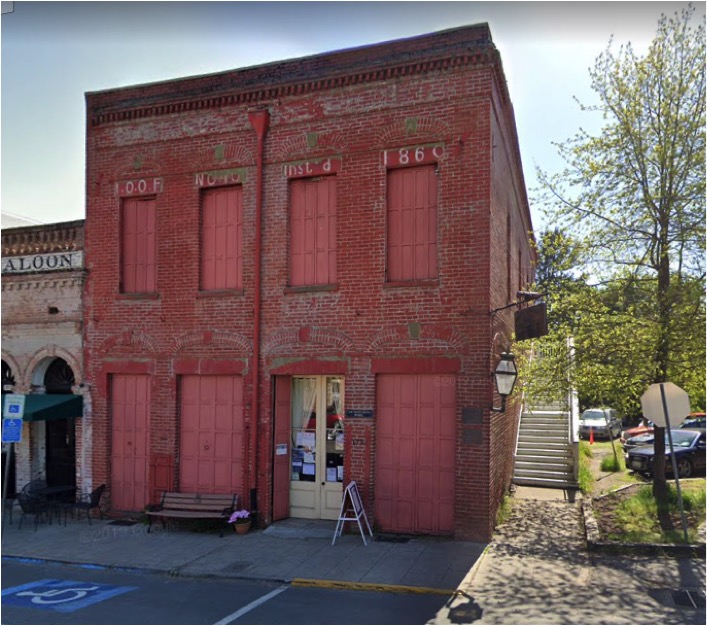 Photo Source: Google Maps. Photo Source: Google Maps.
You may recall the McCully House on California Street, Stop #19 earlier on our tour. John McCully also constructed the first two-story brick structure in Jacksonville, what we now know as the Odd Fellows Hall. But rather than discussing at this point the shameful Dr. John Wilmer McCully who deserted his wife and young family in the face of his mounting debts, let’s talk about the building itself, and the fraternal organization whose name it shares.
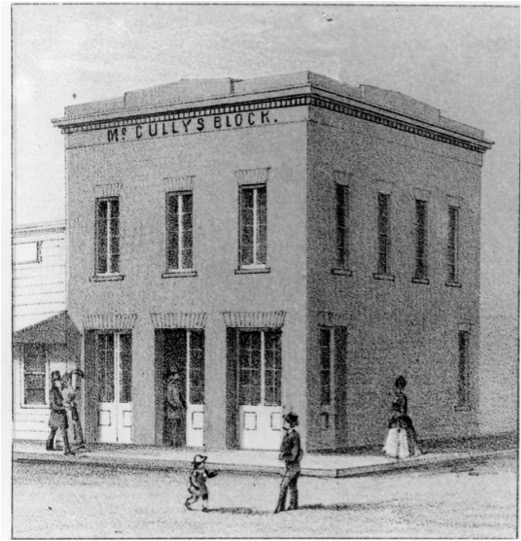 J.W. McCully Block, Lithograph. SOHS #683. J.W. McCully Block, Lithograph. SOHS #683. |
The McCully Building/IOOF Hall was constructed in 1855 or early 1856. In the 1850s, the lower floor was used for shops, including those run by Henry Klippel, William Hoffman, and Kaspar Kubli, Sr. The second floor contained a theater for travelling dramatic troupes that entertained residents of the young town. It was also used for public and religious meetings.
In 1861, the second floor was leased to Jacksonville Lodge No. 10, Independent Order of Odd Fellows, for $300 per year.
In 1862, shortly after John McCully skipped town, the building was auctioned off by the Jackson County Sheriff for $3,100 for unpaid debts; by 1865, it was sold to the IOOF. They required that Jane McCully release her dower right on the property in consideration of $500. With that, the IOOF became the first of the three lodges in Jacksonville to acquire a significant building in town.
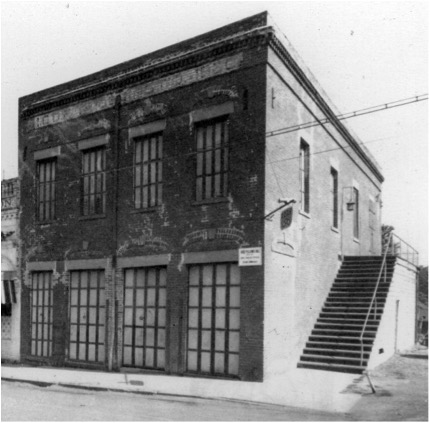 IOOF Building, SOHS #04155. IOOF Building, SOHS #04155. |
As we can see, the building windows and doorways contain heavy iron shutters, designed to help make the building fireproof. They apparently served their purpose well, given that the building survived Jacksonville’s many fires. The four first floor bays on the west façade and the single ground floor bay on the south façade are all doorways. The roof is flat and hidden by a parapet.
While the original founding of the Odd Fellows in Europe is unknown, there are written records of lodges in England in the 1700s. Some sources say the first Odd Fellows Lodge in North America was founded in New York in December of 1806, while other sources indicate the first “Independent” Order  of Odd Fellows was founded in Baltimore in 1819. The New York founders were three boat builders, a comedian and a vocalist – odd fellows indeed. By September of 1851, the Odd Fellows became the first national fraternal organization to accept both men and women when it formed the Daughters of Rebekeh (now, the Rebekehs). The historic mission of the Odd Fellows is to visit the sick, relieve the distressed, bury the dead and educate the orphan. of Odd Fellows was founded in Baltimore in 1819. The New York founders were three boat builders, a comedian and a vocalist – odd fellows indeed. By September of 1851, the Odd Fellows became the first national fraternal organization to accept both men and women when it formed the Daughters of Rebekeh (now, the Rebekehs). The historic mission of the Odd Fellows is to visit the sick, relieve the distressed, bury the dead and educate the orphan.
The Southern Oregon Historical Society has in its archives the original charter issued in 1860 to the Jacksonville Lodge No. 10, identifying Jacksonville’s founding Brethren as William C. Ransome, Eber Emery, Patric Pheeley, James Kilgore, Jesse Robinson, and Isaac Knight.
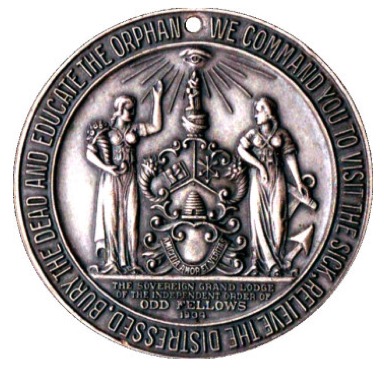 Now, as to John McCully, John and Jane McCully never divorced. John died in Wallowa 28 years after he abandoned his family in Jacksonville. We know he traveled Oregon after he left, and that he spent many years living with and working for his more successful brothers in Union, Wallowa and Yamhill counties. His nephew Frank is credited with the creation of Wallowa county in a split from Union county, and his family were considered founding fathers of the towns there. John’s funeral tribute in the Oregon Statesmen of Salem doesn’t even mention the wife and three children he left destitute in Jacksonville, to say nothing of the massive debt left behind, debt which Jane had to pay off in an era that didn’t offer many opportunities for enterprising women. One wonders whether John’s funeral tribute was so glowing due to the stature of his more successful, and presumably less feckless, brothers. Now, as to John McCully, John and Jane McCully never divorced. John died in Wallowa 28 years after he abandoned his family in Jacksonville. We know he traveled Oregon after he left, and that he spent many years living with and working for his more successful brothers in Union, Wallowa and Yamhill counties. His nephew Frank is credited with the creation of Wallowa county in a split from Union county, and his family were considered founding fathers of the towns there. John’s funeral tribute in the Oregon Statesmen of Salem doesn’t even mention the wife and three children he left destitute in Jacksonville, to say nothing of the massive debt left behind, debt which Jane had to pay off in an era that didn’t offer many opportunities for enterprising women. One wonders whether John’s funeral tribute was so glowing due to the stature of his more successful, and presumably less feckless, brothers.
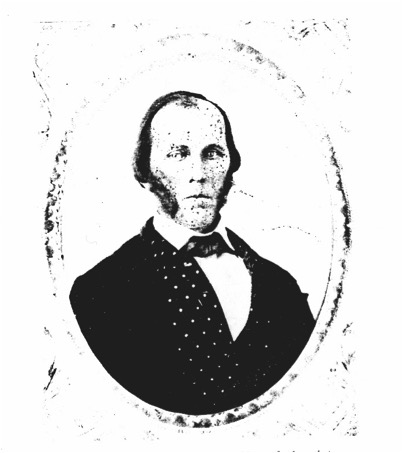 Dr. J.W. McCully, SOHS #6444. Dr. J.W. McCully, SOHS #6444. |
It’s easy to vilify the man who would do such a thing to his family, and yet, like local historian Lynn Ransford raised in her 2012 article for the Rogue Valley Genealogical Society, so many questions remain. How was Jane able to dispose of so much jointly-held property without John’s signature or written consent? Women of the time could file notices regarding separately-held property, but these were jointly-held assets. If John did consent to their liquidation, then why not work things out with his creditors himself? How is it the IOOF building was auctioned off so quickly after he left town; how did the Sheriff know he was never coming back? Why was John left pretty much on his own to continue his life without responsibility, when surely Jane and her children, to say nothing of John’s creditors, knew who his brothers were, where they were, and that they would likely know where he was?
Perhaps John and Jane reached an accommodation prior to his departure; we’ll never know. We do know Jane was left alone to manage with three small children and a mountain of debt. We know that she managed to hang on to her home while clearing that debt by her work ethic and dedication to doing so, despite the fact that in those days women without a male in their lives had few advantages. Yet it is John’s name on this building, and on their home. Perhaps things haven’t changed so much after all.
Sources Cited
Historic American Buildings Survey, Creator, and John W McCully. McCully Building, 175 South Oregon Street, Jacksonville, Jackson County, OR. Retrieved from the Library of Congress, <www.loc.gov/item/or0078/>.
Independent Order of Odd Fellows, odd-fellows.org/.
Ransford, Lynn. “The Rogue Digger.” Dec. 2012.
|